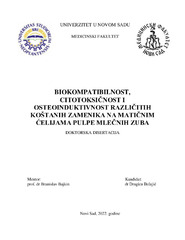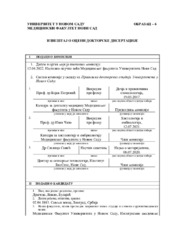Приказ основних података о дисертацији
Biokompatibilnost, citotoksičnost i osteoinduktivnost različitih koštanih zamenika na matičnim ćelijama pulpe mlečnih zuba
Biocompatibility, cytotoxicity and osteoinductivity of different bone substitutes on deciduous tooth pulp stem cells
| dc.contributor.advisor | Bajkin, Branislav | |
| dc.contributor.other | Petrović, Bojan | |
| dc.contributor.other | Čapo, Ivan | |
| dc.contributor.other | Savić, Slavica | |
| dc.contributor.other | Selaković, Srećko | |
| dc.contributor.other | Gušić, Ivana | |
| dc.creator | Булајић, Драгица | |
| dc.date.accessioned | 2022-09-30T09:52:43Z | |
| dc.date.available | 2022-09-30T09:52:43Z | |
| dc.date.issued | 2022-09-20 | |
| dc.identifier.uri | https://www.cris.uns.ac.rs/DownloadFileServlet/Disertacija164984480290326.pdf?controlNumber=(BISIS)120406&fileName=164984480290326.pdf&id=19799&source=NaRDuS&language=sr | sr |
| dc.identifier.uri | https://www.cris.uns.ac.rs/record.jsf?recordId=120406&source=NaRDuS&language=sr | sr |
| dc.identifier.uri | https://www.cris.uns.ac.rs/DownloadFileServlet/IzvestajKomisije164984545371974.pdf?controlNumber=(BISIS)120406&fileName=164984545371974.pdf&id=19800&source=NaRDuS&language=sr | sr |
| dc.identifier.uri | https://nardus.mpn.gov.rs/handle/123456789/20697 | |
| dc.description.abstract | Uvod: Tkivni inženjering je multidisciplinarno polje koje ima za cilj da obnovi, održi ili poboljša funkcije tkiva koja su oštećena ili su izgubljena usled različitih patoloških stanja, bilo razvojem adekvatnih bioloških zamena ili rekonstrukcijom tkiva. Za uspeh u inženjeringu tkiva veoma su važni sledeći faktori: izbor izvora matičnih ćelija, strategije koje se koriste za izolovanje i pasažiranje specifičnih ćelija, izbor biomaterijala koji će se koristiti kao skafold (nosač) i povezanost među njima. Skafoldi mogu biti različitog porekla, pa tako imamo autografte, alografte, ksenografte i aloplastične materijale. Biomehanički sistem kosti je složen tako da idealan skafold treba da ispunjava sledeće uslove: biokompatibilnost, osteokonduktivnost, osteoinduktivnost, sposobnost angiogeneze. Jedan od najperspektivnijih izvora matičnih ćelija za rekonstrukciju koštanih oštećenja jeste zubna pulpa. Matične ćelije zubne pulpe se jednostavno izoluju kako iz mlečnih (SHED) tako i stalnih zuba (DPSC), u in vitro uslovima se lako umožavaju i za nadoknadu oštećenja kostiju se mogu koristiti u kombinaciji sa ili bez skafolda. Ove ćelije su izuzetno proliferativne i sposobne za osteogeno, dentinogeno, adipogeno, hondrogeno, i neurogeno diferenciranje. Cilj ove disertacije je bila izolacija i karakterizacija mezenhimalnih matičnih ćelija zubne pulpe poreklom iz humanih mlečnih zuba koji se nalaze u svojoj fiziološkoj smeni, i potom određivanje biokompatibilnosti ispitivanih biomaterijala (Bio-oss® (Geistlich, Switzerland, dentinskih opiljaka i SBA-16/HA ), i evaluacija ćelijske vijabilnosti nakon kontakta sa njima. Nakon toga je cilj bio diferencirati i imunohistološki potvrditi osteoblastičnu transformaciju mezenhimalnih matičnih ćelija zubne pulpe gajenih u osteogenom medijumu, koje su kasnije korišćene u ispitivanju osteoinduktivnog potencijala različitih koštanih zamenika. Materijal i metode: Eksperimentalni deo istraživanja je podeljen na pet delova. U prvom delu istraživanja je vršena izolacija i karakterizacija SHED na protočnom citometru, u drugom delu je vršena sinteza i karakterizacija SBA-16/HA materijala, u trećem delu eksperimenta je vršeno ispitivanje biokompatibilnosti tri materijala na osnovu standardnih testova biokompatibilnosti: DET testa, MTT testa. U četvrtom delu vršena je diferencijacija i ispitivanje osteogenog kapaciteta SHED. Potvrda dobijenih osteoblasta je vršena alizarin red testom i imunofluorescentnim bojenjem sledećih primatnih antitela: osteopontin, SOX2, Ki-67 i Coll-1. U poslednjem, petom delu eksperimentalne studije određivana je ekspresija osteogenih markera u SHED tretiranim ispitivanim materijalima. Najpre je izolovana iRNK iz ćelija, potom je reakcijom reverzne transkripcije prevedena u iDNK i na kraju je kvanitifikovana u Real time PCR analizi. U analizi su korišeni RUNX2 i ALPL geni. Rezultati: Izolovanjem SHED dobili smo ćelije koje imaju visok proliferativni potencijal i pozitivno eksprimiraju markere matičnih ćelija na protočnom citometru, čime ispunjavaju neophodne kriterijume da budu definisane kao humane mezenhimalne stem ćelije. Na testovima biokompatibilnosti, MTT i DET, novosintetisani SBA-16/HA materijal i kontrolni Bio-oss® su pokazali biokompatibilni i proliferišući efekat na SHED; dok su dentinski opiljci pokazali blagi citotoksični efekat. Nakon perioda inkubacije od tri nedelje u osteogenom medijumu, SHED su se diferencirale u osteoblaste. To smo dokazali prisustvom obojenih kompleksa u kulturi ćelija nakon bojenja alizarin crvenim i pozitivnim imunofluorecentnim bojanjem osteogenim markerima; ćelije su pokazale visoku ekspresiju anti-Coll1 i Osteopontina, dok je ekspresija Ki-67 i anti-SOX2 antitela bila nešto slabija. Od svih ispitivanih materijala, samo su dentinski opiljci pokazali statistički značajna osteoinduktivna svojstva, eksprimirajući ALPL i RUNX2 gene. Materijal Bio-oss® je u sve tri grupe pokazao ekspresiju oba gena koja je niža od kontrolne grupe, dok je SBA-16/HA samo u grupi ektrakta starog 1. dan imao blago povišenu ekspresiju ALPL gena, gena rane ostoblastične diferencijacije. Zaključak: Iz zubne pulpe mlečnih zuba dece izoluju se ćelije koje imaju visok proliferativni potencijal i potencijal diferencijacije u osteoblaste nakon perioda inkubacije od tri nedelje u osteogenom medijumu. Na osnovu ovog istraživanja, SBA-16/HA i Bio-oss® su pokazali pokazali zadovoljavajuć nivo biokompatibilnosti. Sa malom prednošću SBA-16/HA je bio bolji od primenjivanog zlatnog standarda Bio-oss®. Dentinski opiljci koji se već koriste u kliničkoj praksi su pokazali niži nivo biokompatibilnosti, ali visok osteoinduktivni potencijal. | sr |
| dc.description.abstract | Introduction: Tissue engineering is a multidisciplinary field with a goal to restore, maintain or improve the functions of tissues that are damaged or lost due to various pathological conditions, either by developing adequate biological substitutes or tissue reconstruction. The following factors are very important for success in tissue engineering: choice of stem cell source, strategies used to isolate and passage specific cells, choice of biomaterial to be used as scaffold and the bond between them. Scaffolds can be of different origins, so we have autographs, allografts, xenografts and alloplastic materials. The biomechanical system of bone is complex so that the ideal scaffold should have the following properties: biocompatibility, osteoconductivity, osteoinductivity, ability of angiogenesis. One of the most promising sources of stem cells for the reconstruction of bone damage is dental pulp. Dental pulp stem cells are easily isolated from both deciduous (SHED) and permanent teeth (DPSC), are easily hardened in vitro, and can be used in combination with or without scafold to compensate for bone damage. These cells are extremely proliferative and capable of osteogenic, dentinogenic, adipogenic, chondrogenic, and neurogenic differentiation. The aim of this dissertation was to isolate and characterize mesenchymal stem cells of dental pulp originating from human deciduous teeth that are in their physiological shift, and then determine the biocompatibility of the tested biomaterials (Bio-oss® (Geistlich, Switzerland), dentin particules, and SBA/16-HA), and evaluation of cell viability after contact with them. After that, the goal was to differentiate and immunohistologically confirm the osteblastic transformation of mesenchymal stem cells of dental pulp grown in osteogenic medium, which were later used in the study of the osteonductive potential of different bone substitutes. Material and methods: The experimental part of the research is divided into five parts. In the first part of the research the isolation and characterization of SHED on a flow cytometer was performed, in the second part the synthesis and characterization of SBA-16/HA materials was performed, in the third part of the experiment the biocompatibility of three materials was tested based on standard biocompatibility tests: DET and MTT test. The following materials were tested: Bio-oss® (Geistlich AG, Wolhusen, Switzerland), SBA-16/HA and dentin shavings prepared according to the manufacturer's instructions (BonMaker, KDS, Korea). In the fourth part, differentiation and examination of osteogenic capacity of SHED were performed. Confirmation of the obtained osteoblasts was performed by alizarin red test and immunofluorescent staining of the following primary antibodies: osteopontin, SOX2, Ki-67 and Coll-1. In the last, fifth part of the experimental study, the expression of osteogenic markers in SHED-treated test materials was determined. First, the mRNA was isolated from the cells, then converted to cDNA by reverse transcription, and finally quantified in Real time PCR analysis. The RUNX2 and ALPL genes were used in the analysis. Results: By isolating SHED, we obtained cells that have high proliferative potential and positively express stem cell markers on a flow cytometer, thus meeting the necessary criteria to be defined as human mesenchymal stem cells. In biocompatibility tests, MTT and DET, newly synthesized SBA-16/HA material and control Bio-oss® showed a biocompatible and proliferating effect on SHED; while dentin particules showed a mild cytotoxic effect. After a three-week incubation period in osteogenic medium, SHED differentiated into osteoblasts. We proved this by the presence of stained complexes in cell culture after alizarin staining with red and positive immunofluorescent staining with osteogenic markers; cells showed high expression of anti-Coll 1 and Osteopontin, while expression of Ki-67 and anti-SOX 2 antibodies was slightly lower. Of all the materials tested, only dentin particules showed statistically significant osteoinductive properties, expressing the ALPL and RUNX2 genes. Bio-oss® showed expression of both genes lower than the control group in all three groups, while SBA-16/HA had slightly increased expression of the ALPL gene, an early osteoblastic differentiation gene, only in the 1-day-old extract group. Conclusion: Cells with high proliferative potential and potential for differentiation into osteoblasts after an incubation period of three weeks in osteogenic medium are isolated from the dental pulp of children's deciduous teeth. Based on this study, SBA-16/HA and Bio-oss® showed a satisfactory level of biocompatibility. With a slight advantage, SBA-16/HA was better than the applied Bio-oss® gold standard. Dentin particules already used in clinical practice have shown lower levels of biocompatibility but high osteoinductive potential. | en |
| dc.language | sr (latin script) | |
| dc.publisher | Универзитет у Новом Саду, Медицински факултет | sr |
| dc.rights | openAccess | en |
| dc.rights.uri | https://creativecommons.org/licenses/by-nc/4.0/ | |
| dc.source | Универзитет у Новом Саду | sr |
| dc.subject | tkivni inženjering | sr |
| dc.subject | Tissue Engineering | en |
| dc.subject | Mesenchymal Stem Cells | en |
| dc.subject | Tissue Scaffolds | en |
| dc.subject | Biocompatible Materials | en |
| dc.subject | Dental Pulp | en |
| dc.subject | Tooth, Deciduous | en |
| dc.subject | Bone Substitutes | en |
| dc.subject | Osteoblasts | en |
| dc.subject | Dentin | en |
| dc.subject | mezenhimalne stem ćelije | sr |
| dc.subject | nosači tkiva | sr |
| dc.subject | biokompatibilni materijali | sr |
| dc.subject | zubna pulpa | sr |
| dc.subject | mlečni zubi | sr |
| dc.subject | zamene za kosti | sr |
| dc.subject | osteoblasti | sr |
| dc.subject | dentin | sr |
| dc.title | Biokompatibilnost, citotoksičnost i osteoinduktivnost različitih koštanih zamenika na matičnim ćelijama pulpe mlečnih zuba | sr |
| dc.title.alternative | Biocompatibility, cytotoxicity and osteoinductivity of different bone substitutes on deciduous tooth pulp stem cells | en |
| dc.type | doctoralThesis | sr |
| dc.rights.license | BY-NC | |
| dc.identifier.fulltext | http://nardus.mpn.gov.rs/bitstream/id/146062/Disertacija_12586.pdf | |
| dc.identifier.fulltext | http://nardus.mpn.gov.rs/bitstream/id/146063/Izvestaj_komisije_12586.pdf | |
| dc.identifier.rcub | https://hdl.handle.net/21.15107/rcub_nardus_20697 |



